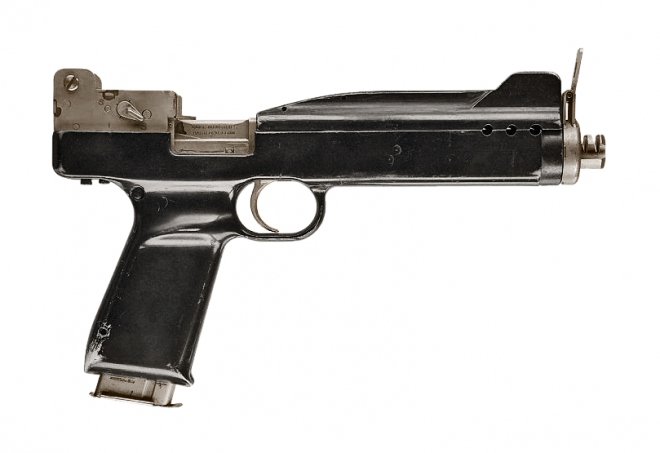1969 was a year of great optimism and achievement for the United States. NASA’s space program took humans to the Moon in July of that year, while the Mariner 6 and 7 probes gave humanity its first close look at the planet Mars. The Boeing 747 “Jumbo Jet” took to the skies for the first time in 1969, and that year also marks the sending of the first ARPANET data packet, heralding the very beginning of the Internet age. In 1969, it seemed as though there was nothing that America could not accomplish, if it wanted to.
In the field of small arms development, the air was filled with that same unbridled optimism. In that year, famed pistol manufacturer Colt Industries began to tackle the problem of not just finding a replacement for the aging M1911 handgun, itself an innovative Colt product, but totally rethinking what the infantry sidearm should look like. The engineers at Colt set out to make a successful machine pistol that could replace the semi-automatic handgun, as it had replaced the revolver, giving second-line personnel an unprecedented combination of both firepower and convenience. The result of their efforts would be called the Colt SCAMP, or “Small CAliber Machine Pistol”, a small, lightweight select-fire 27-shot .22 caliber pistol with a novel mechanism and excellent recoil compensation.
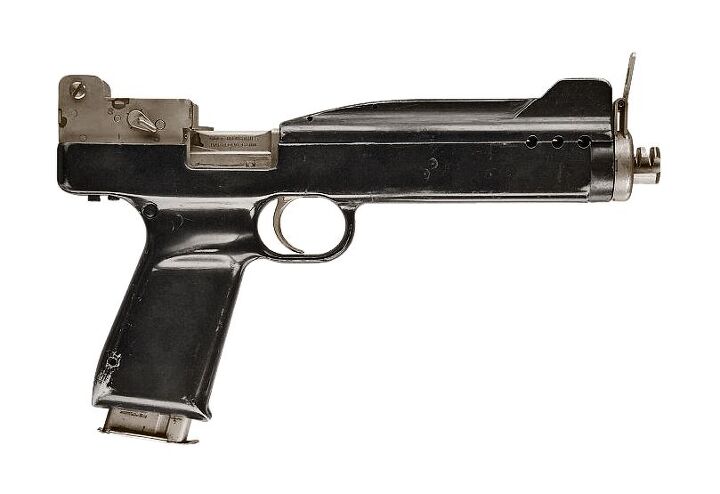
The Colt SCAMP, Small Caliber Machine Pistol. This weapon was a select-fire machine pistol using a .22 caliber high velocity centerfire cartridge, and was a modern PDW ahead of its time. Image source: world.guns.ru, color corrected by Othais of C&Rsenal and used with his permission.
What would become the Colt SCAMP began with a requirement for a truly controllable machine pistol. At the time, the Personal Defense Weapon concept was beginning to take shape. The World War II US M1 Carbine was perhaps the earliest of the modern PDWs, but in the 1960s the U.S. military – the Air Force in particular – sought newer, more effective weapons for support troops and vehicle crewmen in an increasingly mechanized military force. It was thought that a fully automatic handheld weapon that produced controllable fire would enable the person using it to achieve much greater hit probability due to a “garden hose”-esque pattern of fire. However, attaining this degree of controllability in a weapon designed to be used in the hands without a stock or forward grip is easier said than done. One early attempt at providing this degree of firepower was a weapon called the “Davis Gun” (AKA IMP-221 or GUU-4/P), designed by an engineer named Dale Davis in the mid-1960s for an Air Force requirement for an aircrew survival weapon. This gun was chambered in a variant of the .221 Fireball, loaded with an FMJ projectile, and featured a receiver and grip that rotated axially about the barrel, allowing it to be fired with the arm fully outstretched from either right or left hand. While this concept was very influential on the SCAMP, it was considered too large to be a truly convenient weapon that would be small enough for echelon troops to carry on their persons at all times.
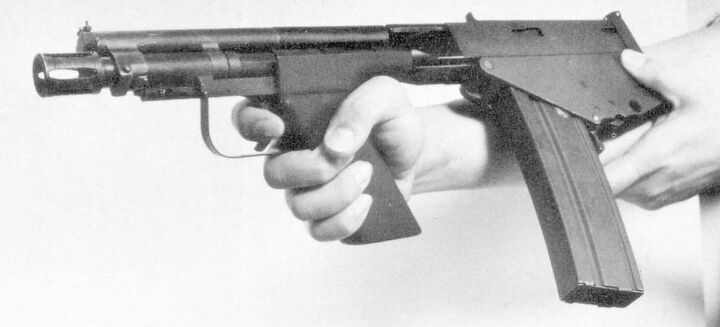
The Colt IMP-221, AKA the “Davis Gun”, showing its ability for the receiver and magazine housing to rotate out of the way of the firer’s arm. This weapon was intended to be fired with the arm extended, like a pistol, and was designed to give aircrews and other personnel the firepower of an infantry rifle at short ranges. Image source: all4shooters.com
For a small, handheld weapon to achieve controllable automatic fire, it had to be designed extremely carefully with regards to ergonomics, recoil compensation, and the impulse of the round it fired. The first step towards a high velocity pistol round was the recognition that the 9x19mm Parabellum cartridge, standardized by NATO earlier in the decade, would not allow this controllable fully automatic fire. The very low impulse .22 Long Rifle was also rejected as being too impotent to be truly useful. Other small rimfire rounds were investigated, including the .22 Winchester Magnum Rimfire and the 5mm Remington Magnum Rimfire, but these rounds were rejected because it was found that the tolerances for the breech mechanism needed for proper function with them were too tight for a military weapon. Colt’s engineering team thus decided to design their own proprietary round for the SCAMP, which was done by cutting down and blowing out the centerfire .22 Hornet round, trimming the rim off the case, cutting a new extractor groove, and loading propellant, a primer, and a 42 grain .22 caliber projectile into the case. Early .22 SCAMP rounds illustrate the directness of this conversion, as they feature a partially intact “.22 HORNET” headstamp. Interestingly, there is an implication in many of the sources that the .22 SCAMP was only intended as a baseline or placeholder round to develop the platform around, and that it would eventually be developed into even smaller caliber rounds, such as saboted multiple flechette variants, or a .17 caliber variant.
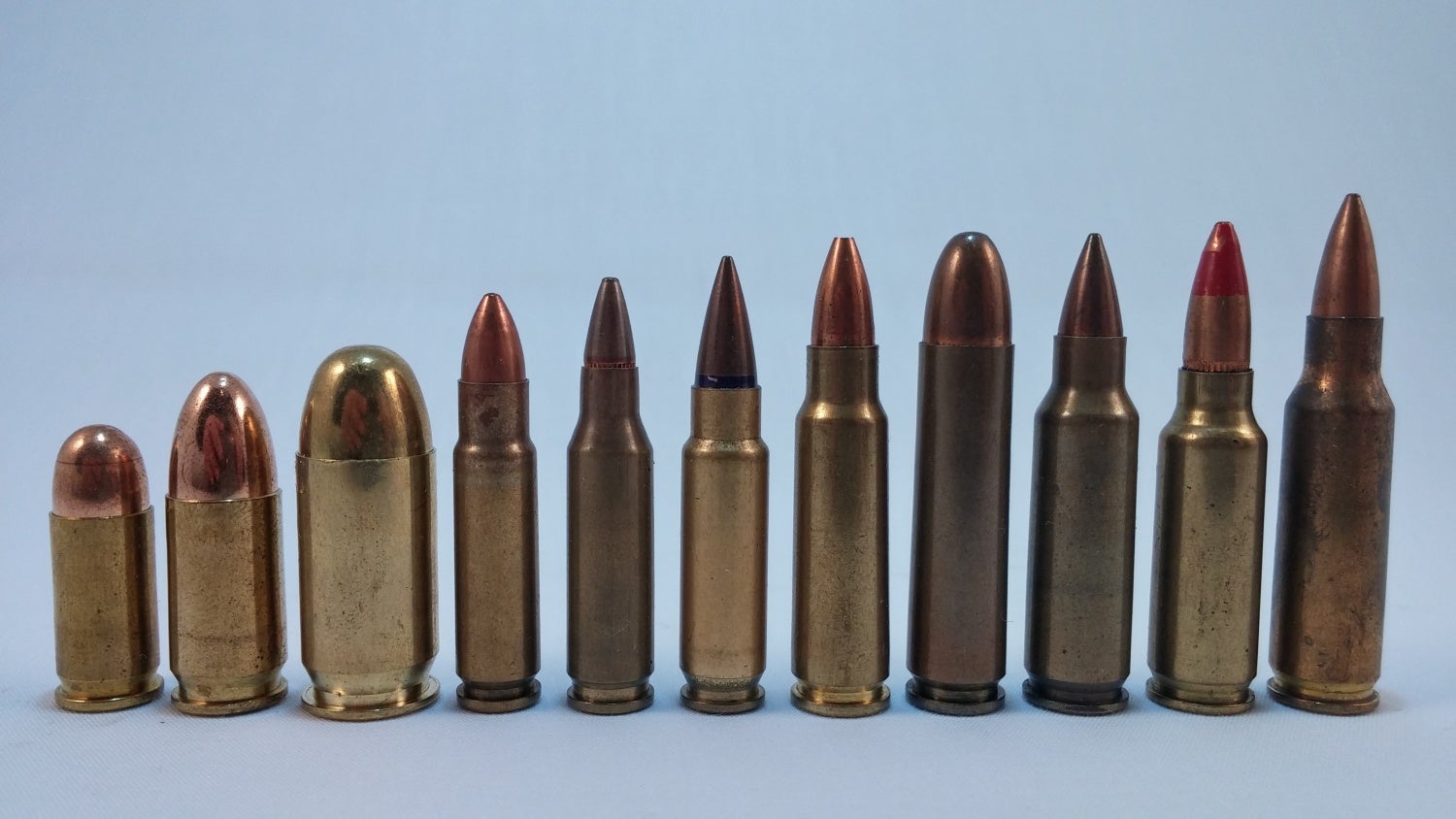
Some of the rounds from the author’s collection. Left to right, .32 ACP (7.65x17SR Browning), 9x19mm Parabellum, .45 ACP, .22 Colt SCAMP, 4.6x30mm HK, 5.7x28mm FN, .22 Johnson Spitfire (5.7×33), .30 Carbine, .22 APG Carbine, 5.56x30mm Colt MARS, .221 Colt IMP. As is highly evident, the .22 SCAMP is a very, very small round, smaller even than the P90’s 5.7x28mm round. This small size, and the correspondingly low impulse of the cartridge when fired, was a key element of the SCAMP.
Later production .22 SCAMP used a 40 grain lead-cored FMJ, producing a muzzle velocity from the machine pistol’s seven-inch barrel of 2,100 ft/s, making the .22 SCAMP a more powerful round than the later and slightly larger 5.7x28mm FN.
By 1970, a Colt design team, lead by the very talented Henry A. Into, had begun constructing a prototype machine pistol to fire the new round. Their requirements were a loaded weight of 3.25 pounds or less, a burst cyclic rate of 1500 rounds per minute, magazine capacity of 27 rounds, a locked breech, gas operated mechanism firing from a closed bolt, and overall dimensions of less than a foot long and less than seven inches high. The pistol was not originally designed with any provision for a shoulder stock or foregrip, and no plans for either are known to exist. The sole prototype machine pistol was constructed of advanced materials for the period, having an impact resistant polymer housing, containing the stainless steel operating components, with minor parts being made from aircraft-grade aluminum. Its mechanism was equally novel: Into and his team analyzed the wide variety of locking systems and operating mechanism used in automatic weapons of all kinds up until that time, and calculated which combination of features would result in the smallest, lightest, cheapest, most reliable weapon. The design born from that analysis was locked into battery by a tilting breechblock, very similar to the Browning Automatic Rifle, or Earl Harvey’s T25 rifle. Motive power for the action was applied at the muzzle to an annular piston – which when combined with corresponding surfaces on the compensator created a gas chamber – operating an internal skeletal slide assembly that actuated cams machined into the breechblock and breech. It was recognized that to attain the best recoil characteristics, the barrel would need to be as low in the grip as possible, therefore the firing mechanism was moved from the usual location to above and behind the mechanism, resulting in the distinctive rear hump of the SCAMP. This mechanism incorporated a novel inverted hammer, swinging down from above, a ratchet-type burst sear, and a three-position selector lever with positions marked S-1-3. The devilishly clever fire control group can be understood with some effort by looking at the patent for the Colt SCAMP, available here.
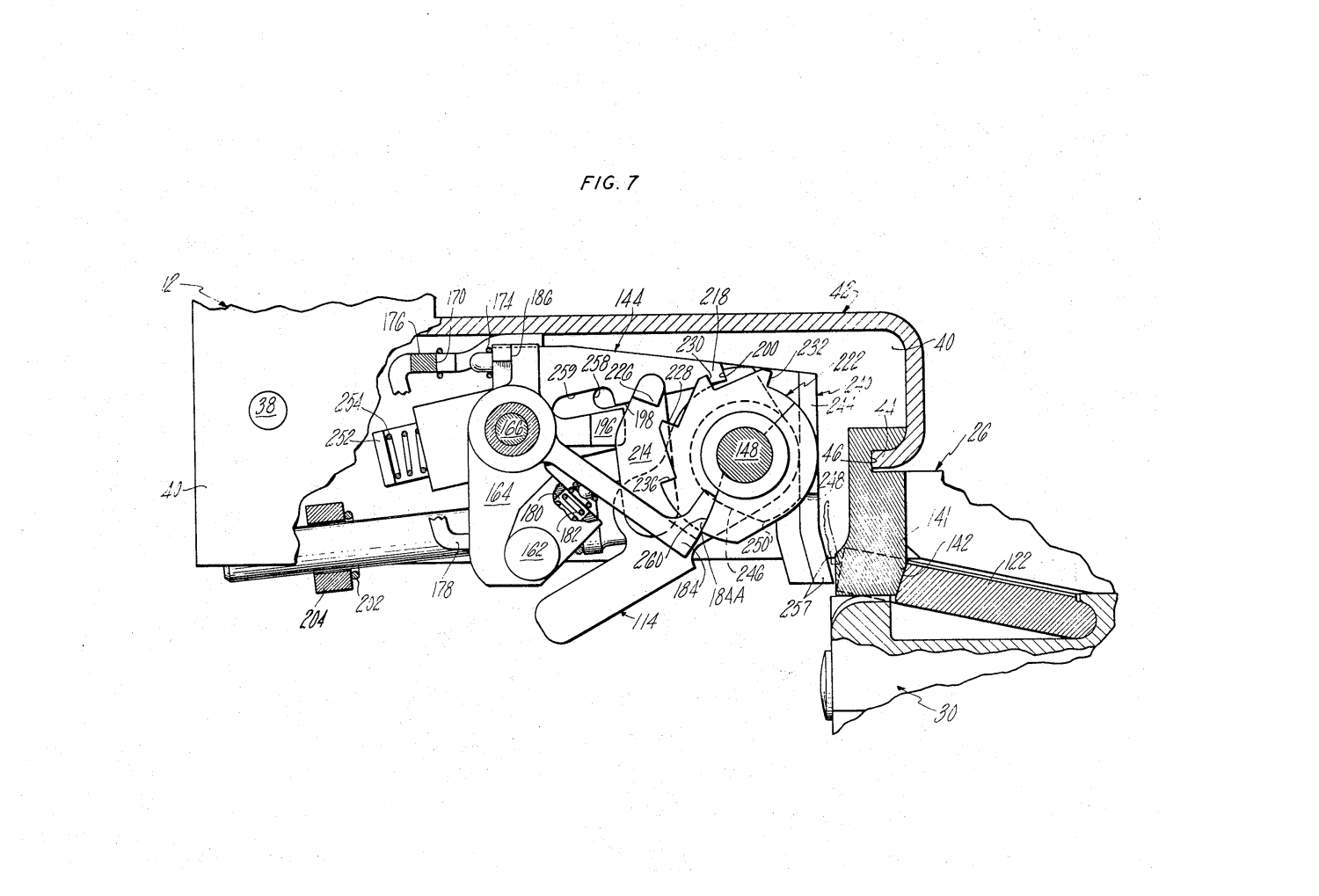
The SCAMP’s compact, but complicated fire control mechanism. Note the tilting breechblock (labeled 122) in the lower right of the image, similar to that of a Browning Automatic Rifle, the downward swinging hammer (labeled 114), and the ratchet-type burst limiter. Image source: google.com/patents.
The SCAMP prototype incorporated sights derived from the M16A1, with a two position flip up rear aperture and an aluminum front post, but the machine pistol also featured a shaped front receiver housing that was designed to act similar to a trap shotgun’s ventilated rib, facilitating rapid, accurate point shooting. The SCAMP’s charging handle was a buried post accessible between the leaves of the housing. A two-cut compensator added a fourth element to the SCAMP’s recoil control system, after the low bore axis, small caliber, high velocity round, and 3 round burst limiter. The prototype clocked in at almost exactly three pounds in weight, fully loaded, and fell well within the dimensional requirements. Since it was designed to be worn, like a handgun, instead of carried like a rifle, several novel arrangements to carry the pistol were designed by Colt engineers, including simply velcroing the pistol to the soldier’s uniform!
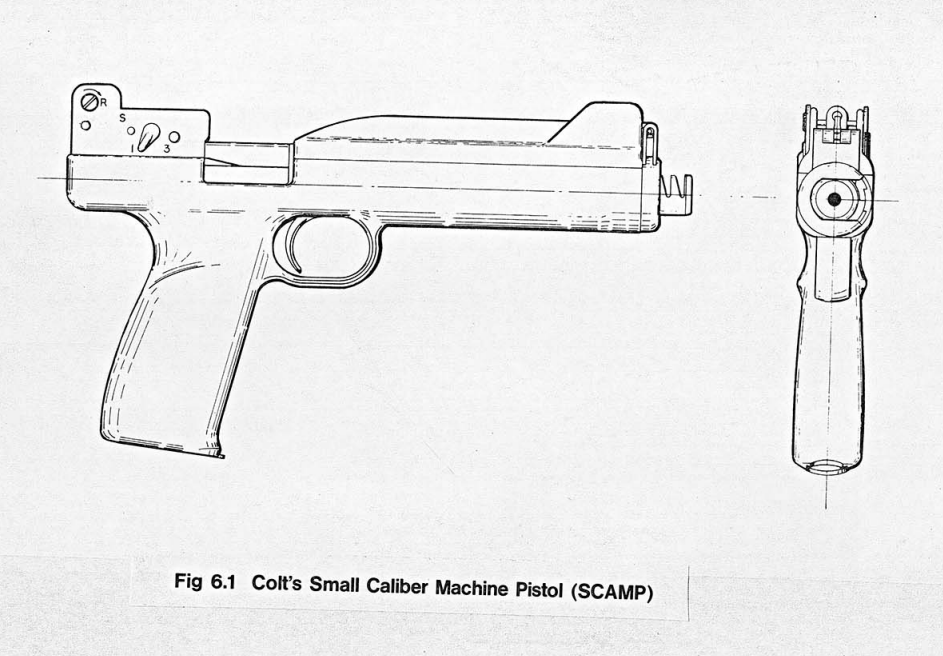
A line drawing of the Colt SCAMP, from a 1969 Colt brochure predating the completion of the first prototype. The brochure can be downloaded from the Small Arms Review website here, and is accompanied by an excellent article by J. David Truby, citing Henry Into, here.
The resulting machine pistol was a major small arms achievement for Colt, and the single prototype marks one of the only stunning technical successes of the small caliber select-fire pistol concept. While larger than the M1911 it had been designed to replace, the SCAMP – unlike later dedicated PDW designs like the Heckler & Koch MP7 or FN P90 – was much closer in size to a traditional pistol than a compact submachine gun. The ingenious mechanisms incorporated into it by Into gave the handgun excellent recoil characteristics according to those who fired it, and the .22 SCAMP cartridge gave it superior muzzle energy to either the later 4.6x30mm or 5.7x28mm rounds when fired from their respective host weapons’ barrels. Unfortunately for Colt, the Army seemed too preoccupied with its own pistol projects (which at the time focused on firing salvos of multiple bullets from a single cartridge) to notice the great potential the SCAMP possessed, and besides some informal testing by Army officials, the little burp gun was never adopted to supplant the M1911. Colt’s management, apparently dissuaded by this, decided not to pursue other markets with the SCAMP, and its development was abandoned. Since then, no major machine pistol design has come close to matching the SCAMP’s excellent combination of small size and high velocity burst firepower.
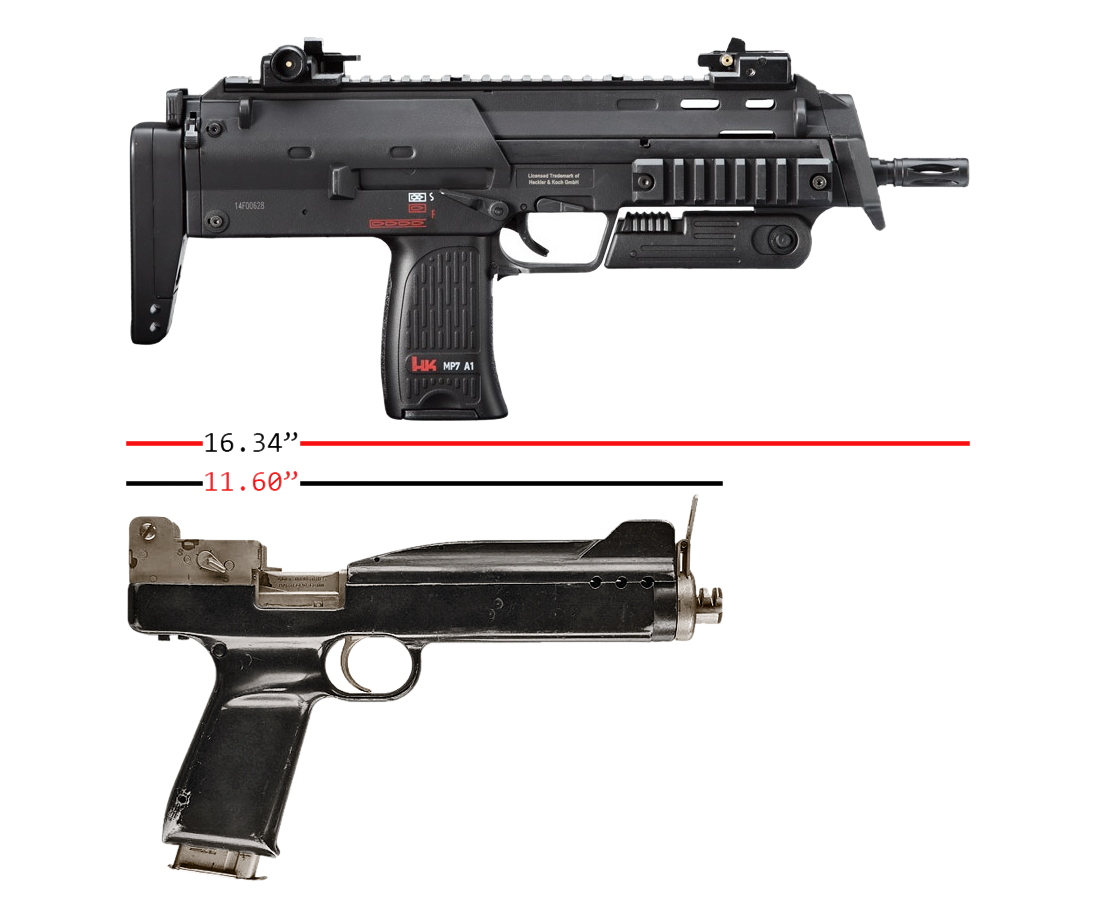
This composite image shows the Colt SCAMP and the H&K MP7A1 to scale with one another. The SCAMP is considerably smaller, despite having the same barrel length as the MP7. In a technical sense, the SCAMP is still one of the most advanced small caliber machine pistols ever designed. Composited and color corrected by Othais of candrsenal.com from images found at kotte-zeller.de and world.guns.ru
 Your Privacy Choices
Your Privacy Choices
